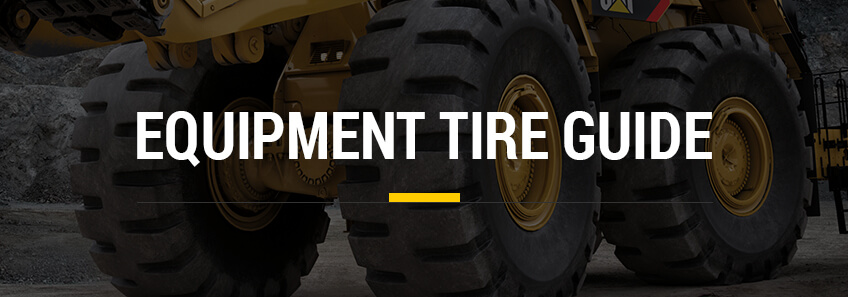
Heavy equipment tires will need to be replaced over time. While you can maintain your tires to increase their lifespans, eventually, you will need to replace them with new tires. Learning about the benefits of Cat® tires versus aftermarket and new versus used will give you the information you need to find the best tires for your fleet. High-quality tires can improve your work crews’ productivity and efficiency.
Jump to Sections:
- How to Increase Tire Lifespan
- How to Maintain Equipment Tires
- When to Replace Tires
- Factors to Consider When Buying Tires
- Benefits of OEM Cat Tires
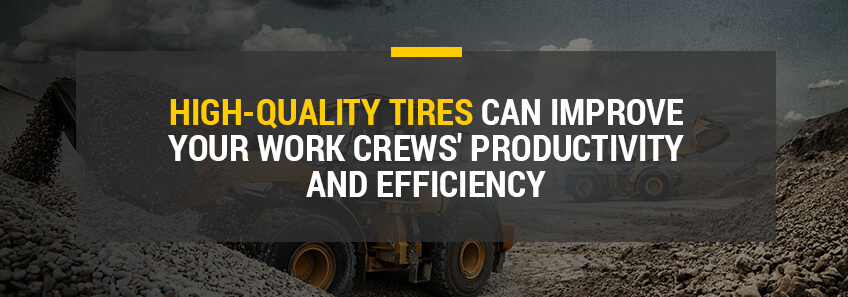
How to Increase Tire Lifespan
Increasing tire lifespan reduces your maintenance costs while keeping efficiency and productivity high. Proper maintenance is only one way to increase the lifespan of your tires and other accessories. Improperly operating equipment can lead to premature wear on tires or damage that will require repair or replacement.
1. Rotate Tires Correctly
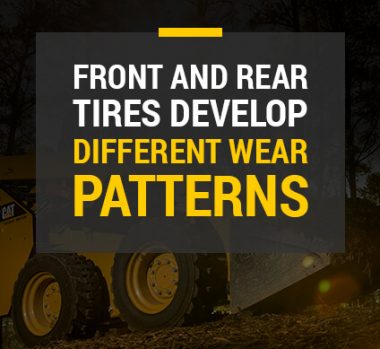 Rotating tires on construction equipment has the same benefits as doing so on cars. Moving the tires to various positions changes how much wear the tread experiences and where it takes place. Tire rotation helps both pneumatic and cushion tires to last longer.
Rotating tires on construction equipment has the same benefits as doing so on cars. Moving the tires to various positions changes how much wear the tread experiences and where it takes place. Tire rotation helps both pneumatic and cushion tires to last longer.
here is no set number of use hours after which you should rotate your tires. However, during regular inspections, you will notice the front and rear wheels will develop differing wear patterns. As soon as you spot this, rotate the tires. Doing so prevents rapid erosion of a specific spot on the tires, extending the life of all four tires. When one set of tires starts to wear, it puts extra strain on the others, speeding up the time between replacements.
Taking the time to rotate tires reduces wear and prevents downtime caused by tire problems on the jobsite.
2. Do Not Exceed Rated Capacities
Check the tires’ rated load capacities and train operators never to handle more than their maximum weight. Standard equipment often prevents the tires from surpassing their load rating. However, with custom attachments that have higher carrying capacities, an operator could potentially use the equipment for heavier weights than the tires can handle.
If you have not done so already, train operators on the maximum loads their equipment tires can handle. Also, do not pair attachments with equipment if the loads carried will exceed the tires’ handling abilities.
Carrying or moving too much weight puts excessive strain on the tires, hastening their rate of wear. While using smaller attachments may take more time, it will still reduce the unexpected downtime from having to repair a tire in the middle of a shift.
3. Inflate Air-Filled Tires Properly
While not all equipment requires air-filled tires, those that do require proper inflation. Tire air pressure is so critical to operations that it is the top predictor of performance. Both underinflating and overinflating tires will negatively affect the tires’ lifespans.
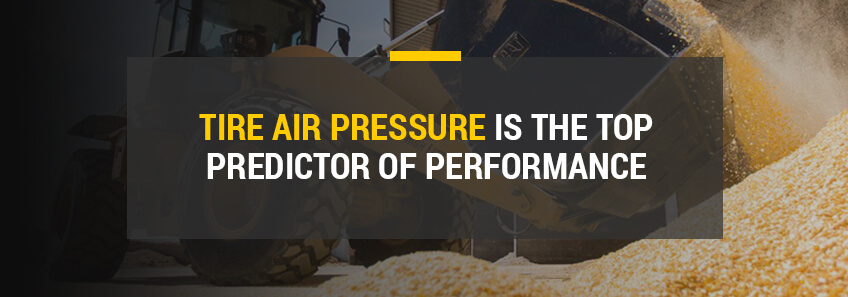
You will shorten tire life by 15% if inflation drops to 10% below its recommended level. When the inflation pressure measures 20% below the correct level, the tire could develop casing fatigue, which occasionally leads to either a zipper rupture or catastrophic failure. Due to the likelihood of disaster with seriously underinflated tires, any that register 20% below the required pressure or more need immediate removal and scrapping. These tires may already have sustained damage.
Overinflating can also be detrimental to tire life. With 30% more air pressure than required in the tire, its life shrinks by 50%. Under and over-inflating tires can lead to more than just faster wear. Either of these conditions can also cause sidewall damage and the development of holes in the crown from rocks.
Look up the tire manufacturer’s recommended inflation pressure. Each manufacturer may have different pressure requirements, which depend on the tire size, the equipment it pairs with and the design of the tire.
Inflating tires adequately also protects the operator and equipment. Not having the correct air pressure in the tires impacts the amount of stress the rest of the system undergoes. Tires function as part of the suspension system. Not having them inflated correctly can make the ride uncomfortable for the operator and increase the strain on the equipment. Both of these factors can affect productivity.
4. Avoid Rough Terrain and Obstacles
Operating equipment in wet or hot conditions can cause the tires to wear much faster than in dry, cool weather. When wet, operators must avoid sharp objects and rough terrain. Compared to a dry tire, a wet one has a ten times higher likelihood of damage, such as cuts, during use. Train operators to avoid using equipment in wet weather or to restrict their driving to smooth surfaces.
Heat also poses a problem during use. Pavement can reach scorching temperatures, surpassing the temperature of the air. When driving equipment in 120-degree Fahrenheit weather, the tires deposit rubber with each rotation. Excessive use of loaders in these conditions can significantly wear down tires, reducing their lifespan.
For some tires, driving over paved roadways can lead to premature wear. For example, skid steer loaders typically have tires for off-road only use. Driving these loaders on paved roadways or surfaces for extended periods can wear down the tires faster than if the loader stayed off the road.
5. Protect Tires From the Elements
Whether stored separately or on a vehicle, keep tires in a dry, cool location. Set the tires on the tread for storage and never stack them. Keep the tires protected from rain, snow, ice and direct sun. Ozone sources can also damage stored tires. Avoid using arc-welders and mercury vapor light bulbs around tire storage areas.
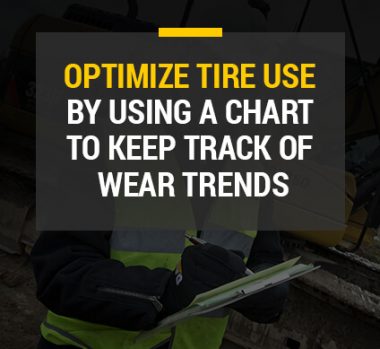 6. Track Tire Use
6. Track Tire Use
Tracking your tires’ usage does not require high-tech equipment. Use a basic chart to keep tabs of how many hours your tires last, what equipment you install them on and the causes of their failures. Over time, you will see trends that will help you make changes to optimize your tire use. For example, excessive tire replacements due to stones causing deep cuts in the rubber could indicate too much debris on the site or equipment driving through rubble piles where they should not go. Changing the situations and behaviors that cause frequent tire failures in your fleet will increase the lives of the remaining tires you use.
Maintain Tires
Proper maintenance ensures your tires stay in top condition. The regular inspections conducted during maintenance chores ensure you never have a bad tire on a piece of equipment. Bad tires cause delays in work until the loader has a replacement installed on it. To keep your jobsite running smoothly, take care of all equipment tires, so your fleet rides on only the best.
1. Keep Tires Clean
After every shift, clean off the tires as much as possible. Road salt, mud and other substances can contribute to faster tire wear. Using soap and water to remove potentially wearing products can help keep your tires lasting longer.
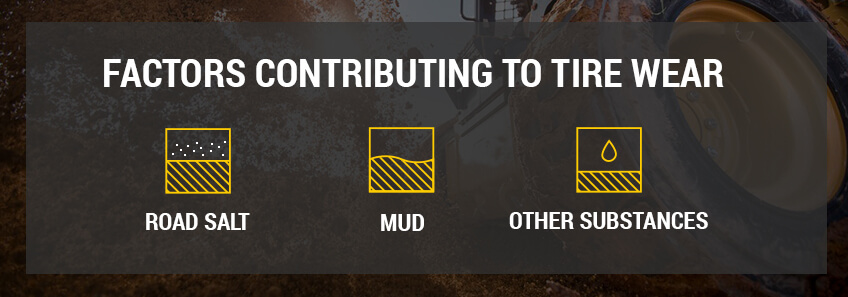
A quick rinse of the tires also helps during tire inspections. Unless the operator can see the tires, he or she cannot spot problems such as debris, holes, bubbles and cracks. A layer of mud or dirt over the tire may hide these until the tire begins to fail from the unseen damage.
2. Verify Tire Alignment
Look over the tires for proper alignment. Hitting debris could knock the steering out of alignment, which affects the direction the tires point. Improper alignment causes uneven tire wear.
During regular servicing of the equipment, check for wheel alignment and uneven wear on tires that could indicate bent steering components.
3. Maintain Correct Air Pressure
Maintaining correct air pressure helps to lengthen the lifespans of tires, but it should also be an essential part of their regular service and maintenance. For tires not attached to the vehicles, never add or remove air from them if they are not inside safety cages. Do not stand behind the tires during inflation. Remain at the side to avoid injury.
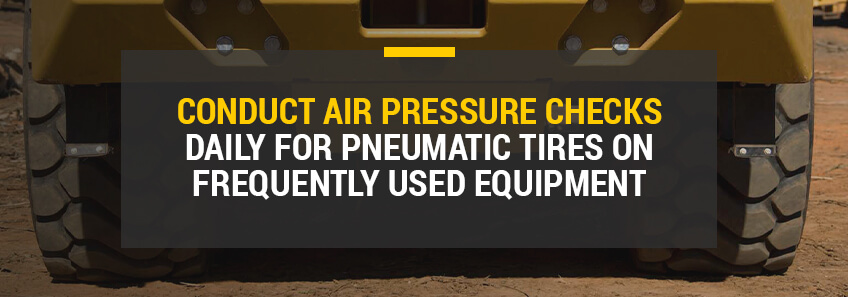
Conduct air pressure checks of all pneumatic tires daily for frequently used equipment. For less frequently used tires, check the air pressure weekly.
4. Use the Correct Tire Size for Equipment and Application
When selecting tires for construction, choose tires designed for the equipment and application. Different treads are ideal for different terrains, and different tire sizes fit specific loaders. For example, you have options for rock treads intended for working on hard surfaces. Smooth treads do not wear as quickly but offer little traction. Rib patterns supply little ground clearance but provide necessary traction on road surfaces.
Your choice between pneumatic and solid tires also depends on the terrain and use. Pneumatic tires offer sturdy tread and a comfortable ride, but they wear out more quickly and require frequent airchecks. Solid tires have smooth surfaces that last much longer than pneumatic tires, but these do not offer as much traction and make the ride more uncomfortable.
Alternatives, such as Cat Flexport™ tires, can combine the best of both types. These tires offer 58% greater tread depth and a puncture-proof design that make them useful in a wide variety of terrains. They’re long-lasting like solid tires and improve rider comfort like pneumatic tires do. Flexport wheel loader and skid steer tires provide the best of both worlds.
5. Inspect Tires and Rims Daily
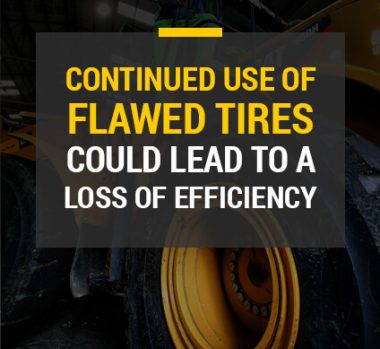 Each day, regular maintenance must include checking the tires and rims. During the tire inspection, look for debris and signs of damage. Look out for the following problems:
Each day, regular maintenance must include checking the tires and rims. During the tire inspection, look for debris and signs of damage. Look out for the following problems:
- Stone drilling
- Cracks
- Cuts
- Uneven wear
- Bubbles
- Bumps
- Sealing valve caps in place
- Missing bolts
- Cracked studs
- Bent rim
If you spot any of these problems in a tire, replace the tire and rim before the equipment goes back out onto the worksite. Continuing to use a tire with any of the above flaws could lead to a loss in efficiency or significant injury on the jobsite.
Know When to Replace Tires
Even with the best tire maintenance and careful use, you will eventually need to replace the tires on your equipment. Look for these signs of worn tires that require replacement. Knowing the right time to replace tires will save you money and increase your productivity. If you replace tires too soon, you will waste money, but changing them too late puts operators at risk of falling behind on work and having accidents.
1. Tires Used While Underinflated
You must replace tires that are underinflated by 20% or more if an operator used the tire on a vehicle. Putting such tires under stress increases the chances of potentially dangerous failure. Instead of risking a lost load or another catastrophe from a failed tire, replace any severely underinflated tires before their equipment returns to work.
2. Loss of Tread
Your worksite conditions will dictate how much tread your tires need. As the tires wear down, the tread will reach a critical level where an operator cannot properly control the equipment. Once tires lose enough tread to become dangerous in your worksite’s conditions, replace them.
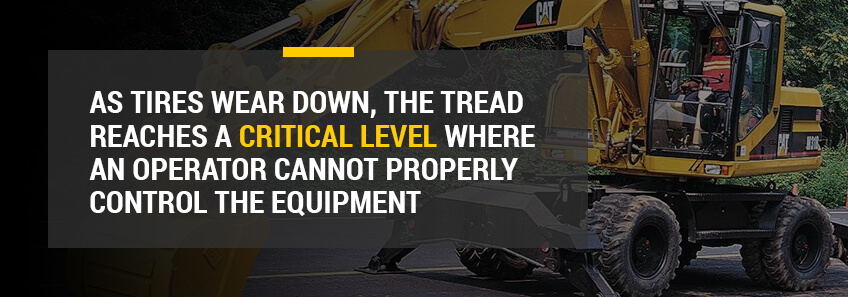
3. Flat Tires
A flat tire will not supply enough support, nor will it offer suitable handling for the operator. Replace any flat tires on equipment. If an operator notices a flat or visibly low tire, he or she should return the equipment for service. Train operators to never work with this type of tire defect. Repairing the tire may restore its shape, but that quick fix will only last for a short while before the tire loses air again. Replacing flat tires is the best option to protect your fleet from unexpected tire failures.
Factors to Consider When Buying Tires
Do not buy the cheapest tires you can find. Doing so puts you at risk of having to purchase replacement tires more often. Cheap tires can also affect your fleet’s efficiency on the jobsite. Do not let price be your only deciding factor.
You pair the tires with the equipment and the work you need to have done, so why would you put any less thought into buying tires for your fleet. You have options that include Cat tires and aftermarket as well as new and used. To get the most life from your tires, use those recommended for the equipment, which for Cat products will be new Cat tires. Here’s why these tires stand out from the rest.
1. Benefits of Cat Tires vs. Aftermarket
Cat tires offer several advantages you won’t find with other brands. No other company makes Flexport tires, which blend the best of solid and pneumatic tires into long-lasting alternatives that pair well with Cat equipment.
What sets Flexport tires apart from other brands is their unique construction. Engineers with the Caterpillar company designed these tires from the ground up to offer improved performance for skid steers and wheel loaders. The tires feature elliptical-shaped holes in their sides that are stronger than the circular gaps found on other tire brands.
The ports improve the ride comfort for the operator, while puncture-proof design and an all-in-one tire and rim construction enhance the strength and longevity of the tire. With three different tread options to match your needs, you can find the ideal type of Flexport skid steer or wheel loader tires for your worksite.
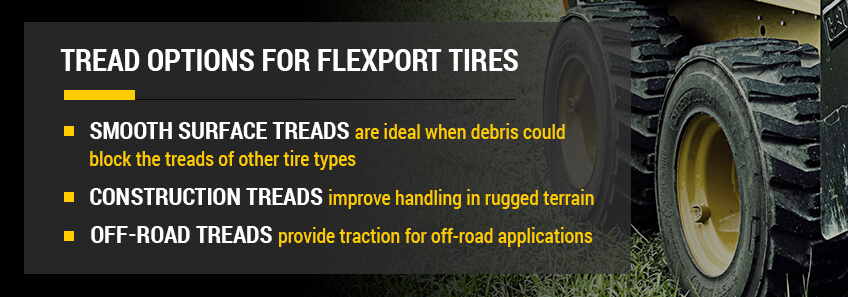
Smooth surface tires are the best choice when you have equipment in a landfill, demolition site or recycling center where debris could block the treads of other tire types.
Deeper construction treads improve handling in rugged terrain. If you have smaller equipment that can easily maneuver through a busy worksite, you can use Flexport tires with construction treads. These tires grip the ground well, whether using the equipment on sand, turf or soil.
Off-road tires have block-shaped tread. These tires have the traction to manage off-road applications. The block shape of these tires’ treads, though, works best when not used in areas with excessive debris. Refuse from a construction site or garbage from a landfill could block the treads, reducing the tires’ traction and handling.
Do not worry about carrying heavy loads or full buckets while using equipment with these tires. The elliptical ports can hold up to even the heaviest loads, as long as you do not exceed the maximum tire capacity rating. The ports do not collapse, so these tires have fewer stress points than those with circular ports. You get tires that last longer than aftermarket options.
While tough, the ports also offer ride cushioning for the operator. Because they won’t feel excessive vibrations during the shift, operators can work longer between breaks. More comfortable operators can work harder and longer, helping your project to stay on schedule.
If you cannot decide between aftermarket and Cat tires, consider the benefits you lose when you choose aftermarket tires. While you might save a few dollars, the tires won’t last as long, and you might compromise rider comfort. Both situations cut into your worksite’s productivity. Choose the tires made for your Cat equipment and replace your worn tires with those from the Cat Flexport line.
2. Benefits of New Tires vs. Used Tires
When you know that you need replacement tires for your equipment, you might think buying used tires will save money. Just like buying aftermarket tires for your Cat equipment, you will not actually save money over time. You must carefully consider the downsides to used tires when making your tire selection.
You cannot definitively know the quality of used tires. Even well-restored tires can have slightly worn tread and matching exact levels of wear becomes difficult. Having even wear on all your equipment tires ensures expected performance.
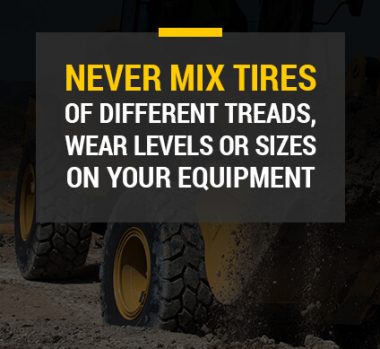 Never mix tires of different treads, wear levels or sizes on your equipment. Each piece of equipment on your worksite has specific requirements for the tires under it. Using a mixture of tires puts the equipment at an uneven angle and does not support the load or operator as needed. Mixing tires could lead to internal damage to the equipment due to improper traction or support.
Never mix tires of different treads, wear levels or sizes on your equipment. Each piece of equipment on your worksite has specific requirements for the tires under it. Using a mixture of tires puts the equipment at an uneven angle and does not support the load or operator as needed. Mixing tires could lead to internal damage to the equipment due to improper traction or support.
Used tires already have hours of wear on them. You will need to replace them more regularly than new tires. Also, consider any warranties available. New Cat tires have a separate warranty on them, ensuring you get the highest quality parts. The warranty covers any workmanship or material defects in the tires, which have construction that meets the exacting standards for all Cat equipment.
When you cannot decide between new and used tires, consider how many more hours new tires will give you. The extra time becomes even more important when your worksite covers rugged terrain that can wear out tires quickly. Well-made, new Cat tires will keep your equipment running, which ensures your crews can get their jobs done on time.
Discover How New Cat Tires Can Improve Your Worksite’s Productivity
When you need new tires, partner with a company that specializes in providing you with both heavy equipment and the tires you need for it. Visit any of our MacAllister Machinery locations in Indiana or Michigan’s lower peninsula. Our vast selection of parts and equipment includes Cat components and more. We also offer unparalleled customer service throughout your experience, from your first contact with us to long after your purchase.
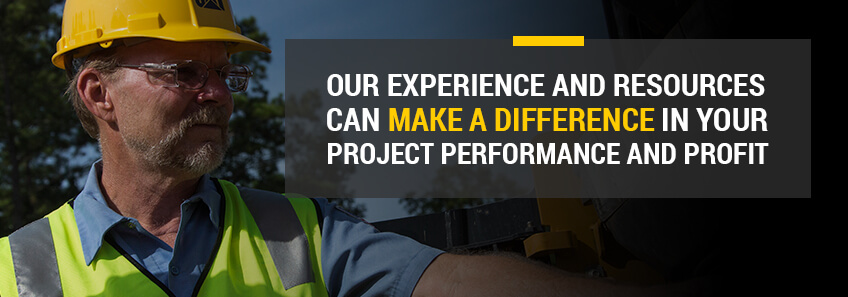
Let us help you get the tires your fleet needs. With the right tires, your operators can get more done during each shift, boosting your site’s total efficiency. Contact us for more information about buying tires or getting any other Cat parts for your equipment.
